
Radiographic study of the caudal cervical facet joints
In clinical practice an increasing number of young Warmblood horses (4-6 years) shows caudal facet joint changes. This may be with or without neurological symptoms, like ataxia which is secondary to spinal cord compression. It can also be a source of neck pain and neck stiffness. This study investigated the associations of enlargement of the facet joints at C5-C6 and C6-C7 with the breed, age, sex and usage of the horse and any clinical signs seen.
The radiographs of 122 horses were included. Age range was between 8 months and 25 years. Whereof 42 Thoroughbreds, 18 Warmbloods and 32 Thoroughbred cross. 38,5% of the horses were used for general purpose and 20,5% for competition. Disciplines of 44 horses had not been recorded. In order to standardise the interpretation of the facet joint enlargement, a grading system was developed.
The outcome data of this study shows that the size of the caudal cervical facet joints at the level of C5-C6, increase significant with age, but not in C6-C7. Hence enlarged facet joints at the level of C5-C6 and C6-C7 may not be abnormal. If enlarged caudal facet joints are noted in young horses, then this could be abnormal. In this study, no associations for enlargement and breed, sex or discipline of the horse were found. However, this may be due to the study population.
If abnormal clinical findings associated with the caudal cervical spine are found then the facet joints may still be clinically relevant and should be assessed with other imaging modalities, like diagnostic ultrasound.
> From: Down et al., Equine vet. J. 41 (2017) 518-524. All rights reserved to EVJ Ltd. Click here for the online summary.


